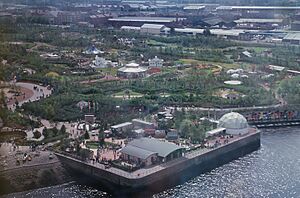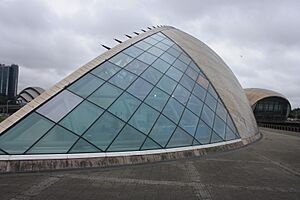Glasgow Science Centre facts for kids

Glasgow Science Centre and Glasgow Tower, the tallest structure in Scotland
|
|
| Established | 2001 |
|---|---|
| Location | Glasgow, Scotland |
The Glasgow Science Centre is a super cool place to visit in Glasgow, Scotland! It's located right by the River Clyde in an area called Clyde Waterfront Regeneration. Queen Elizabeth II officially opened it on July 5, 2001. It's one of Scotland's most popular places to visit, especially for families and kids who love science.
This amazing science centre has three main buildings: the Science Mall, the Glasgow Tower, and an IMAX cinema. It's also a charity, which means it's run to help people learn, not just to make money.
The Scottish tourist board, VisitScotland, has given the Glasgow Science Centre a five-star rating, which is the highest award for visitor attractions! Besides its main location, the Glasgow Science Centre also helps manage the visitor centre at Whitelee Wind Farm, which opened in 2009.
Contents
History of the Science Centre

The Glasgow Science Centre first opened its doors in June 2001. It's part of a big project to make the Pacific Quay area, which used to be a busy cargo port called Prince's Dock, into a modern place. This big change started way back in 1988 with the Glasgow Garden Festival.
After the festival, the land was supposed to be used for houses. But because of a housing slowdown, much of the area stayed empty for many years. Eventually, parts of it were used for the Science Centre. New buildings for BBC Scotland and Scottish Television also opened nearby in 2006 and 2007. The original Clydesdale Bank Tower was moved to North Wales, but the Glasgow Tower, which is part of the Science Centre, stands in almost the same spot.
The main architects for the Glasgow Science Centre were Building Design Partnership. The Glasgow Tower was designed by Richard Horden. The whole project cost about £75 million, with £10 million just for the Glasgow Tower! A lot of the money, over £37 million, came from the Millennium Commission.
Each of the three main buildings has a different metal covering. The IMAX cinema is covered in titanium, the Science Mall in stainless steel, and the Glasgow Tower in aluminium. The Science Mall was originally covered in titanium, making it one of the first buildings in Britain with this special covering. In 2018, the roof of the Science Mall needed repairs. It was fixed with new stainless steel shingles, and the work was finished in 2023.
Exploring the Science Mall
The Science Mall is the biggest of the three buildings. It's shaped like a crescent, which looks a bit like the side of a ship. This design is a nod to the "canting basin" nearby, where ships used to be tilted to clean their bottoms!
Inside, there are three floors packed with over 250 hands-on science exhibits. These exhibits are designed to be interactive, meaning you can touch, play, and experiment with them. It's a fun way to learn about science without even realizing it!
What You'll Find on Each Floor
- Floor 1: Here you'll find lots of interactive exhibits that show how science works. You can also watch exciting shows at the Science Show Theatre and explore the stars at the Glasgow Science Centre Planetarium. The planetarium uses a special digital system to project images onto a huge 15-metre dome. There's also a special area just for younger kids called The Big Explorer.
- Floor 2: This floor lets you discover where our energy comes from and how we can live in a more eco-friendly way in the 'Powering the Future' exhibition. You can also celebrate amazing ideas in the 'Idea No59' exhibition. There's also The Lab, which is mainly used for educational workshops.
- Floor 3: This floor was updated in 2012 and reopened in March 2013. It now has an interactive exhibition called BodyWorks, all about human health and how we live in the 21st century. You can learn about your body, health, and lifestyle through 115 interactive exhibits and live lab experiences.
The Ground Floor of the Science Mall is where you buy tickets, grab a snack at the cafes, or find a souvenir at the gift shop. There are also flexible rooms like The Bothy and the Clyde Suite, used for different events. You also access the Glasgow Tower and the IMAX cinema from this floor.
The Glasgow Tower
The Glasgow Tower was designed to be the tallest tower in the world that can spin all the way around! It had some challenges when it first opened in 2001 and was closed for a few years, from August 2010 until July 2014.
The IMAX Cinema
The IMAX cinema at the Glasgow Science Centre was the very first IMAX cinema built in Scotland. It has a huge screen, measuring about 80 feet by 60 feet, and can seat 370 people. It can show both 2D and amazing 3D films in the special IMAX format.
The cinema first opened in October 2000, even before the other two main buildings. It showed its first film, "Dolphins," months before the Science Mall opened. In September 2013, Cineworld started running the cinema. However, in May 2021, Cineworld decided not to operate it anymore. The good news is that the Glasgow Science Centre announced the IMAX theatre reopened on May 5, 2022!
In the Media
The Glasgow Science Centre is located in the Pacific Quay area, which is a hub for media companies. With new headquarters for STV opening in 2006 and BBC Pacific Quay in 2007, you might see more TV shows filmed around the Science Centre.
For example, in the CBeebies TV show Nina and the Neurons, the main character, Nina, is a neuroscientist who works at the Glasgow Science Centre. In real life, Nina is played by actress Katrina Bryan, who isn't actually a staff member at the Science Centre.
See also
- Dynamic Earth - A science centre in Edinburgh, Scotland
- Aberdeen Science Centre - A science centre in Aberdeen, Scotland
- Dundee Science Centre - A science centre in Dundee, Scotland
- List of science centers#Europe


